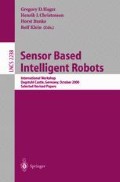Abstract
Traditionally, feature extraction and correspondence determination are handled separately in motion analysis of (range) image sequences. The correspondence determination methods have typically an exponential computational complexity. In the present paper we introduce a novel framework of motion analysis that unifies feature extraction and correspondence determination in a single process. Under the basic assumption of a small relative motion between the camera and the scene, feature extraction is solved by refining the segmentation result of the previous frame. This way correspondence information becomes directly available as a by-product of the feature extraction process. Due to the coupled processing of frames we also enforce some degree of segmentation stability. First results on real range image sequences have demonstrated the potential of our approach.
Access this chapter
Tax calculation will be finalised at checkout
Purchases are for personal use only
Preview
Unable to display preview. Download preview PDF.
References
J.K. Aggarwal and N. Nandhakumar, On the computation of motion from sequences of images-A review, Proceedings of IEEE, 76(8): 917–935, 1988.
J.K. Aggarwal, Q. Cai, W. Liao, and B. Sabata, Nonrigid motion analysis: Articulated and elastic motion, Computer Vision and Image Understanding, 70(2): 142–156, 1998.
M. Asada, M. Kimura, Y. Taniguchi, and Y. Shirai, Dynamic integration of height maps into a 3D world representation from range image sequences, International Journal of Computer Vision, 9(1): 31–53, 1992.
A.P. Ashbrook, R.B. Fisher, C. Robertson, and N. Werghi, Segmentation of range data into rigid subsets using surface patches, Proc. of ICCV, 201–206, 1998.
C.M. Bastuscheck, Techniques for real-time generation of range images, Proc. of CVPR, 262–268, 1989.
S.S. Beauchemin and J.L. Barron, The computation of optical flow, ACM Computing Surveys, 27(3): 433–467, 1995.
J.A. Beraldin, M. Rioux, F. Blais, L. Cournoyer, and J. Domey, Registered intensity and range imaging at 10 mega-samples per second, Optical Engineering, 31(1): 88–94, 1992.
A. Blake and A. Yuille (Eds.), Active vision, The MIT Press, 1992.
A. Blake and M. Isard, Active contours, Springer-Verlag, 1998.
K. Chaudhury, R. Mehrotra, C. Srinivasan, Detecting 3-D motion field from range image sequences, IEEE Transactions on Systems, Man, and Cybernetics, Part B: Cybernetics, 29(2): 308–312, 1999.
H.H. Chen and T.S. Huang, Maximal matching of two three-dimensional point sets, Proc. of ICPR, 1048–1050, 1986.
J.-C. Cheng and H.-S. Don, A graph matching approach to 3-D point correspondences, International Journal of Pattern Recognition and Artificial Intelligence, 5(3): 399–412, 1991.
A. Escobar, D. Laurendeau, J. Cote, and P. Hebert, Tracking moving objects using range data, Proc. of 30th Int. Symposium on Automotive Technology & Automation: Robotics, Motion and Machine Vision in the Automotive Industries, 77–84, 1997.
H. Haussecker and H. Spies, Motion, in: Handbook of Computer Vision and Applications (B. Jähne, H. Haussecker, and P. Geissler, Eds.), Academic Press, 1999.
A. Hoover, G. Jean-Baptiste, X. Jiang, P.J. Flynn, H. Bunke, D. Goldgof, K. Bowyer, D. Eggert, A. Fitzgibbon, and R. Fisher, An experimental comparison of range image segmentation algorithms, IEEE Transactions on Pattern Analysis and Machine Intelligence, 18(7): 673–689, 1996.
B.K.P. Horn and J.G. Harris, Rigid body motion from range image sequences, CVGIP: Image Understanding, 53(1): 1–13, 1991.
H. Hügli and C. Schütz, Geometric matching of 3D objects: Assessing the range of successful initial configuration, Proc. of Int. Conf. on Recent Advances in 3-D Digital Imaging and Modeling, 101–106, 1997.
T.S. Huang and A.N. Netravali, Motion and structure from feature correspondences: A review, Proceedings of IEEE, 82(2): 252–268, 1994.
R.C. Jain and A.K. Jain (Eds.), Analysis and interpretation of range images, Springer-Verlag, 1990.
X. Jiang and H. Bunke, Edge detection in range images based on scan line approximation, Computer Vision and Image Understanding, 73(2): 183–199, 1999.
X. Jiang, An adaptive contour closure algorithm and its experimental evaluation, IEEE Transactions on Pattern Analysis and Machine Intelligence, 22(11): 1252–1265, 2000.
X. Jiang, K. Bowyer, Y. Morioka, S. Hiura, K. Sato, S. Inokuchi, M. Bock, C. Guerra, R.E. Loke, and J.M.H. du Buf, Some further results of experimental comparison of range image segmentation algorithms, Proc. of 15th Int. Conf. on Pattern Recognition, Vol. 4, 877–881, Barcelona, 2000.
A. Joshi and C.-H. Lee, On the problem of correspondence in range data and some inelastic uses for elastic nets, IEEE Transactions on Neural Networks, 6(3): 716–723, 1995.
N. Kehtarnavaz and S. Mohan, A framework for estimation of motion parameters from range images, Computer Vision, Graphics, and Image Processing, 45(1): 88–105, 1989.
M.W. Powell, K.W. Bowyer, X. Jiang, and H. Bunke, Comparing curved-surface range image segmenters, Proc. of ICCV, 286–291, 1998.
B. Sabata and J.K. Aggarwal, Estimation of motion from a pair of range images: A review, CVGIP: Image Understanding, 54(3): 309–324, 1991.
B. Sabata and J.K. Aggarwal, Surface correspondence and motion computation from a pair of range images, Computer Vision and Image Understanding, 63(2): 232–250, 1996.
H. Spies, B. Jähne, and J.L. Barron, Regularised range flow, Proc. of ECCV, 785–799, 2000.
J. Tajima and M. Iwakawa, 3-D data acquisition by rainbow range flnder, Proc. of ICPR, 309–313, 1990.
M. Yamamoto, P. Boulanger, J.A. Beraldin, and M. Rioux, Direct estimation of range.ow on deformable shape from a video range camera, IEEE Transactions on Pattern Analysis and Machine Intelligence, 15(1): 82–89, 1993.
Author information
Authors and Affiliations
Editor information
Editors and Affiliations
Rights and permissions
Copyright information
© 2002 Springer-Verlag Berlin Heidelberg
About this paper
Cite this paper
Jiang, X., Hofer, S., Stahs, T., Ahrns, I., Bunke, H. (2002). A New Technique for the Extraction and Tracking of Surfaces in Range Image Sequences. In: Hager, G.D., Christensen, H.I., Bunke, H., Klein, R. (eds) Sensor Based Intelligent Robots. Lecture Notes in Computer Science, vol 2238. Springer, Berlin, Heidelberg. https://doi.org/10.1007/3-540-45993-6_6
Download citation
DOI: https://doi.org/10.1007/3-540-45993-6_6
Published:
Publisher Name: Springer, Berlin, Heidelberg
Print ISBN: 978-3-540-43399-6
Online ISBN: 978-3-540-45993-4
eBook Packages: Springer Book Archive

